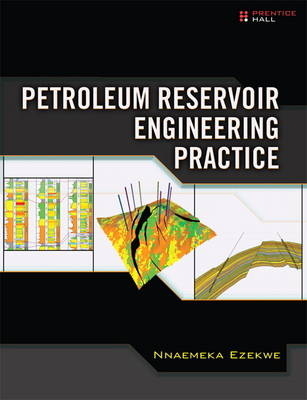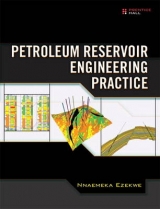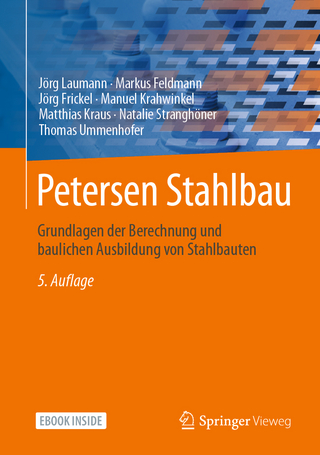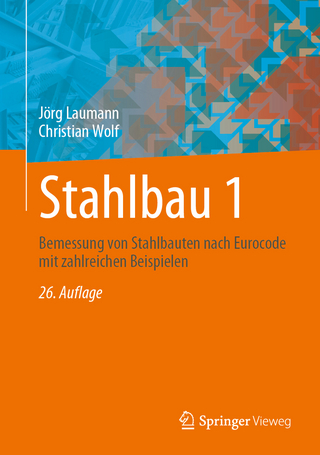
Petroleum Reservoir Engineering Practice
Prentice Hall (Verlag)
978-0-13-715283-4 (ISBN)
- Titel erscheint in neuer Auflage
- Artikel merken
This is a complete, up-to-date guide to the practice of petroleum reservoir engineering, written by one of the world’s most experienced professionals. Dr. Nnaemeka Ezekwe covers topics ranging from basic to advanced, focuses on currently acceptable practices and modern techniques, and illuminates key concepts with realistic case histories drawn from decades of working on petroleum reservoirs worldwide.
Dr. Ezekwe begins by discussing the sources and applications of basic rock and fluid properties data. Next, he shows how to predict PVT properties of reservoir fluids from correlations and equations of state, and presents core concepts and techniques of reservoir engineering. Using case histories, he illustrates practical diagnostic analysis of reservoir performance, covers essentials of transient well test analysis, and presents leading secondary and enhanced oil recovery methods.
Readers will find practical coverage of experience-based procedures for geologic modeling, reservoir characterization, and reservoir simulation. Dr. Ezekwe concludes by presenting a set of simple, practical principles for more effective management of petroleum reservoirs.
With Petroleum Reservoir Engineering Practice readers will learn to
• Use the general material balance equation for basic reservoir analysis
• Perform volumetric and graphical calculations of gas or oil reserves
• Analyze pressure transients tests of normal wells, hydraulically fractured wells, and naturally fractured reservoirs
• Apply waterflooding, gasflooding, and other secondary recovery methods
• Screen reservoirs for EOR processes, and implement pilot and field-wide EOR projects.
• Use practical procedures to build and characterize geologic models, and conduct reservoir simulation
• Develop reservoir management strategies based on practical principles
Throughout, Dr. Ezekwe combines thorough coverage of analytical calculations and reservoir modeling as powerful tools that can be applied together on most reservoir analyses. Each topic is presented concisely and is supported with copious examples and references. The result is an ideal handbook for practicing engineers, scientists, and managers—and a complete textbook for petroleum engineering students.
Nnaemeka Ezekwe holds B.S., M.S., and Ph.D. degrees in chemical and petroleum engineering, and an MBA, all from the University of Kansas. For many years, he worked in several supervisory roles including manager of reservoir evaluation and development for Bechtel Petroleum Operations. As a senior petroleum engineer advisor for Pennzoil and later Devon Energy, he performed reservoir engineering analyses on many domestic and worldwide projects. Nnaemeka was an SPE Distinguished Lecturer in 2004–2005, during which he spoke on reservoir management strategies and practices to audiences in 33 countries in Africa, Asia, Europe, Middle East, and North and South America. He has published numerous technical papers on chemical and petroleum engineering topics. Nnaemeka is a registered professional engineer in California and Texas.
Preface xiii Acknowledgments xxv
About the Author xxix
Chapter 1: Porosity of Reservoir Rocks 1
1.1 Introduction 1
1.2 Total Porosity and Effective Porosity 1
1.3 Sources of Porosity Data 3
1.4 Applications of Porosity Data 10
Nomenclature 12
Abbreviations 13
References 13
General Reading 14
Chapter 2: Permeability and Relative Permeability 15
2.1 Introduction 15
2.2 Sources of Permeability Data 16
2.3 Relative Permeability 23
2.4 Sources of Relative Permeability Data 25
2.5 Three-Phase Relative Permeability 32
2.6 Applications of Permeability and Relative Permeability Data 32
Nomenclature 33
Abbreviations 34
References 34
General Reading 37
Chapter 3: Reservoir Fluid Saturations 39
3.1 Introduction 39
3.2 Determination of Water Saturations 40
3.3 Determination of Reservoir Productive Intervals 48
Nomenclature 49
Abbreviations 50
References 50
General Reading 52
Chapter 4: Pressure-Volume-Temperature (PVT) Properties of Reservoir Fluids 53
4.1 Introduction 53
4.2 Phase Diagrams 53
4.3 Gas and Gas-Condensate Properties 63
4.4 Pseudo-critical Properties of Gas Mixtures 67
4.5 Wet Gas and Gas Condensate 70
4.6 Correlations for Gas Compressibility Factor 78
4.7 Gas Formation Volume Factor (FVF) 79
4.8 Gas Density 81
4.9 Gas Viscosity 82
4.10 Gas Coefficient of Isothermal Compressibility 83
4.11 Correlations for Calculation of Oil PVT Properties 93
4.12 Correlations for Calculation of Water PVT Properties 103
Nomenclature 104
Subscripts 106
References 106
General Reading 108
Chapter 5: Reservoir Fluid Sampling and PVT Laboratory Measurements 111
5.1 Overview of Reservoir Fluid Sampling 111
5.2 Reservoir Type and State 116
5.3 Well Conditioning 119
5.4 Subsurface Sampling Methods and Tools 119
5.5 Wireline Formation Testers 121
5.6 PVT Laboratory Measurements 130
5.7 Applications of Laboratory PVT Measurements 134
Nomenclature 138
Subscripts 138
Abbreviations 139
References 139
General Reading 140
Appendix 5A: Typical Reservoir Fluid Study for a Black Oil Sample 142
5A.1 Reservoir Fluid Summary 142
5A.2 Calculated Analysis of Reservoir Fluid 143
5A.3 Pressure-Volume Properties at 212°F (Constant Composition Expansion) 144
5A.4 Differential Liberation at 212°F 145
5A.5 Gas Differentially Liberated at 212°F 146
5A.6 Viscosity Data at 212°F 147
5A.7 Comparison of Reservoir Oil Flash Liberation Tests 147
Appendix 5B: Typical Reservoir Fluid Study for a Gas Condensate Sample 148
5B.1 Summary of Reservoir Data and Surface Sampling Conditions 148
5B.2 Chromatograph Analysis of Separator Gas at 1140 psig and 92°F 150
5B.3 Chromatograph Analysis of Separator Liquid at 1140 psig and 92°F 151
5B.4 Composition of Reservoir Fluid (Calculated) 152
5B.5 Measured Saturation Pressures from Stepwise Recombinations at 267°F 152
5B.6 Pressure-Volume Properties of Reservoir Fluid at 267°F (or CCE) 153
5B.7 Depletion Study at 267°F: Hydrocarbon Analyses of Produced Wellstream (Mole %) 154
5B.8 Retrograde Condensation During Gas Depletion at 267°F 155
Chapter 6: PVT Properties Predictions from Equations of State 157
6.1 Historical Introduction to Equations of State (EOS) 157
6.2 van der Waals (vdW) EOS 158
6.3 Soave-Redlich-Kwong (SRK) EOS 159
6.4 Peng-Robinson (PR) EOS 162
6.5 Phase Equilibrium of Mixtures 162
6.6 Roots from Cubic EOS 164
6.7 Volume Translation 165
6.8 Two-Phase Flash Calculation 168
6.9 Bubble Point and Dew Point Pressure Calculations 170
6.10 Characterization of Hydrocarbon Plus Fractions 171
6.11 Phase Equilibrium Predictions with Equations of State 174
Nomenclature 178
Subscripts 179
Superscripts 179
Abbreviations 179
References 180
Chapter 7: The General Material Balance Equation 183
7.1 Introduction 183
7.2 Derivation of the General Material Balance Equation (GMBE) 183
7.3 The GMBE for Gas Reservoirs 187
7.4 Discussion on the Application of the GMBE 188
Nomenclature 189
Subscripts 189
Abbreviations 189
References 190
Chapter 8: Gas Reservoirs 191
8.1 Introduction 191
8.2 Volumetric Gas Reservoirs 192
8.3 Gas Reservoirs with Water Influx 198
8.4 Water Influx Models 202
8.5 Geopressured Gas Reservoirs 213
8.6 Case Histories of Two Gas Reservoirs 221
Nomenclature 247
Subscripts 248
Abbreviations 248
References 248
General Reading 250
Appendix 8A: Correlations for Estimating Residual Gas Saturations for Gas Reservoirs under Water Influx 251
Appendix 8B: Dimensionless Pressure for Finite and Infinite Aquifers 252
Appendix 8C: Dimensionless Pressure for Infinite Aquifers 253
Chapter 9: Oil Reservoirs 255
9.1 Introduction 255
9.2 Oil Reservoir Drive Mechanisms 255
9.3 Gravity Drainage Mechanism 257
9.4 Volumetric Undersaturated Oil Reservoirs 258
9.5 Undersaturated Oil Reservoirs with Water Influx 264
9.6 Volumetric Saturated Oil Reservoirs 276
9.7 Material Balance Approach for Saturated Oil Reservoirs with Water Influx 279
9.8 Case History of Manatee Reservoirs 279
Nomenclature 292
Subscripts 292
Abbreviations 293
References 293
Chapter 10: Fluid Flow in Petroleum Reservoirs 295
10.1 Introduction 295
10.2 Fluid Types 296
10.3 Definition of Fluid Flow Regimes 297
10.4 Darcy Fluid Flow Equation 301
10.5 Radial Forms of the Darcy Equation 302
10.6 Derivation of the Continuity Equation in Radial Form 310
10.7 Derivation of Radial Diffusivity Equation for Slightly Compressible Fluids 311
10.8 Solutions of the Radial Diffusivity Equation for Slightly Compressible Fluids 313
10.9 Derivation of the Radial Diffusivity Equation for Compressible Fluids 321
10.10 Transformation of the Gas Diffusivity Equation with Real Gas Pseudo-Pressure Concept 322
10.11 The Superposition Principle 327
10.12 Well Productivity Index 338
10.13 Well Injectivity Index 338
Nomenclature 339
Subscripts 340
References 340
General Reading 341
Appendix 10A: Chart for Exponential Integral 342
Appendix 10B: Tabulation of pD vs tD for Radial Flow, Infinite Reservoirs with Constant Terminal Rate at Inner Boundary 343
Appendix 10C: Tabulation of pD vs tD for Radial Flow, Finite Reservoirs with Closed Outer Boundary and Constant Terminal Rate at Inner Boundary 345
Appendix 10D: Tabulation of pD vs tD for Radial Flow, Finite Reservoirs with Constant Pressure Outer Boundary and Constant Terminal Rate at Inner Boundary 350
Appendix 10E: Tabulation of QD vs tD for Radial Flow, Infinite Reservoirs with Constant Terminal Pressure at Inner Boundary 358
Appendix 10F: Tabulation of QD vs tD for Radial Flow, Finite Reservoirs with Closed Outer Boundary and Constant Terminal Pressure at Inner Boundary 361
Chapter 11: Well Test Analysis: Straightline Methods 367
11.1 Introduction 367
11.2 Basic Concepts in Well Test Analysis 368
11.3 Line Source Well, Infinite Reservoir Solution of the Diffusivity Equation with Skin Factor 378
11.4 Well Test Analyses with Straightline Methods 381
11.5 Special Topics in Well Test Analyses 432
Nomenclature 439
Subscripts 440
Abbreviations 441
References 441
General Reading 444
Chapter 12: Well Test Analysis: Type Curves 445
12.1 Introduction 445
12.2 What Are Type Curves? 445
12.3 Gringarten Type Curves 447
12.3.1 Unit-Slope Line 448
12.4 Bourdet Derivative Type Curves 449
12.5 Agarwal Equivalent Time 450
12.6 Type-Curve Matching 451
12.7 Procedures for Manual Application of Type-Curve Matching in Well Test Analysis 452
12.8 Stages of the Type-Curve Matching Procedures 454
Nomenclature 459
Subscripts 460
Abbreviations 460
References 461
Appendix 12A: Characteristic Shapes of Pressure and Pressure-Derivative Curves for Selected Well, Reservoir, and Boundary Models 463
Appendix 12B: Buildup Test Data for Example 12.1 467
Appendix 12C: Calculation of Pressure Derivatives 473
Chapter 13: Well Test Analysis: Hydraulically Fractured Wells and Naturally Fractured Reservoirs 475
13.1 Introduction 475
13.2 Hydraulically Fractured Wells 475
13.3 Definition of Dimensionless Variables for Fractured Wells 476
13.4 Flow Regimes in Fractured Wells 476
13.5 Fractured Well Flow Models 478
13.6 Fractured Well Test Analysis: Straightline Methods 480
13.7 Fractured Well Test Analysis: Type-Curve Matching 487
13.8 Naturally Fractured Reservoirs 497
13.9 Naturally Fractured Reservoir Models 497
13.10 Well Test Analysis in Naturally Fractured Reservoirs Based on Double Porosity Model 505
13.11 Well Test Analysis in NFRs: Straightline Method s 506
13.12 Well Test Analysis in NFRs: Type Curves 509
13.13 Procedure for Analysis of Well Test from NFRs Assuming Double Porosity Behavior 512
Nomenclature 520
Subscripts 521
Abbreviations 521
References 522
General Reading 523
Chapter 14: Well Test Analysis: Deconvolution Concepts 525
14.1 Introduction 525
14.2 What Is Deconvolution? 525
14.3 The Pressure-Rate Deconvolution Mod el 526
14.4 Application of Deconvolution to Pressure-Rate Data 528
14.5 Examples on the Application of the von Schroeter Deconvolution Algorithm to Real Well Test Data 529
14.6 General Guidelines for Application of von Schroeter Deconvolution Algorithm to Pressure-Rate Data from Well Tests 534
References 535
General Reading 536
Chapter 15: Immiscible Fluid Displacement 537
15.1 Introduction 537
15.2 Basic Concepts in Immiscible Fluid Displacement 538
15.3 Fractional Flow Equations 544
15.4 The Buckley-Leverett Equation 549
15.5 The Welge Method 553
15.6 Summary 559
Nomenclature 560
References 561
General Reading 562
Chapter 16: Secondary Recovery Methods 563
16.1 Introduction 563
16.2 Waterflooding 564
16.3 Gasflooding 575
Nomenclature 580
Abbreviations 580
References 580
General Reading 582
Chapter 17: Enhanced Oil Recovery 583
17.1 Introduction 583
17.2 EOR Processes 584
17.3 EOR Screening Criteria 587
17.4 Miscible Gas Injection Processes 589
17.5 Methods for Determination of MMP or MME for Gasfloods 595
17.6 Types of Miscible Gas Flooding 612
17.7 Chemical Flooding Processes 614
17.8 Thermal Processes 616
17.9 Implementation of EOR Projects 624
Nomenclature 630
Abbreviations 630
References 631
General Reading 638
Chapter 18: Geologic Modeling and Reservoir Characterization 641
18.1 Introduction 641
18.2 Sources of Data for Geologic Modeling and Reservoir Characterization 641
18.3 Data Quality Control and Quality Assurance 644
18.4 Scale and Integration of Data 644
18.5 General Procedure for Geologic Modeling and Reservoir Characterization 645
Nomenclature 676
Abbreviations 676
References 677
General Reading 678
Chapter 19: Reservoir Simulation 681
19.1 Introduction 681
19.2 Derivation of the Continuity Equation in Rectangular Form 684
19.3 Flow Equations for Three-Phase Flow of Oil, Water, and Gas 686
19.4 Basic Concepts, Terms, and Methods in Reservoir Simulation 689
19.5 General Structure of Flow Reservoir Models 706
Nomenclature 708
Subscripts 709
Abbreviations 709
References 710
General Reading 714
Chapter 20: Reservoir Management 717
20.1 Introduction 717
20.2 Reservoir Management Principles 718
20.3 Case Histories Demonstrating Applications of Reservoir Management Principles 720
References 741
General Reading 744
Index 745
| Erscheint lt. Verlag | 14.10.2010 |
|---|---|
| Verlagsort | Upper Saddle River |
| Sprache | englisch |
| Maße | 231 x 184 mm |
| Gewicht | 1428 g |
| Themenwelt | Technik ► Bauwesen |
| Technik ► Elektrotechnik / Energietechnik | |
| Technik ► Umwelttechnik / Biotechnologie | |
| ISBN-10 | 0-13-715283-3 / 0137152833 |
| ISBN-13 | 978-0-13-715283-4 / 9780137152834 |
| Zustand | Neuware |
| Haben Sie eine Frage zum Produkt? |
aus dem Bereich



